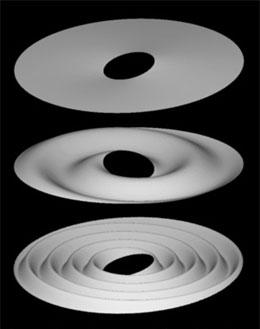Wobbles in the rings of Saturn and Jupiter preserve a record of past impacts.
Zeeya Merali

The rings of Saturn and Jupiter contain ripples caused by comets that hit them decades ago. Monitoring how the rings wobble could reveal how common comet impacts are and may also help astronomers map the planets' cores.
Matthew Hedman, an astronomer at Cornell University in Ithaca, New York, and his colleagues spotted the ripple in one of Saturn's rings in images taken by the Cassini spacecraft in 2009. Sunlight striking the rings edge-on revealed previously unseen bright and dark bands in the planet's C ring, which lies between about 74,600 and 92,000 kilometres from the planet's centre. "It's the same thing you see when sunlight races across a corrugated tin roof," says Hedman.
The undulations appear because particles in the rings are moving up and down, like people in a Mexican wave. The ripple formed when part of the ring was knocked out of kilter. As time passed, this tilt has become a progressively tighter spiral, meaning that the shorter the ripple's wavelength, the longer ago it was formed.
Using this relationship, Hedman and his colleagues calculated that the ripple began in 1983 and reasoned that it was caused by an unseen comet impact. As the comet broke up, they argue, its cloud of debris with a total mass between 1011 and 1013 kilograms bashed into the ring particles, making the ring tilt and wobble. Earlier Cassini images also showed signs of a ripple in the adjacent D Ring, probably caused during the same strike, Hedman says.
 http://www.nature.com/news/2011/110331/full/news.2011.198.html
http://www.nature.com/news/2011/110331/full/news.2011.198.htmlThe universe's biggest Cymbal...bada bing bada boom!